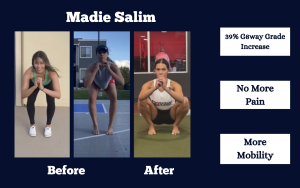-
What is Back Chain Dominance?
Believe it or not, five years ago the term back chain dominance was not really a thing. Sure, the posterior side of the body always existed, but the health and wellness community did not know the importance of the posterior chain until recently. To this day, you will hear that having a healthy core (on the front side of the body) is the key to having a healthy back. Furthermore, the theory that developing core muscles will offer a life with no back pain has been around for a long time. Unfortunately, it couldn’t be more inaccurate.
The problem is that most of the exercises performed for core training are anti-rotational. The idea of “bracing the core” in movement doesn’t let the spine work correctly from side to side. Instead, it causes the body to rotate less freely than it would with back chain dominance. Our G8way Max coaches know how to get our clients out of back pain. We give you the movement patterns to obtain a long decompressed spinewith the ability to move freely from side to side.
So let’s talk about what Back Chain Dominance is.
Have you ever heard of “forward tilt?” Well, that’s actually a natural or innate shape of the body. We should have a slight forward tilt when we are resting. We should always have a forward tilt when walking or running. When we begin losing this forward tilt, our hips start resting in front of the body with the ribcage behind the hips (backward tilt), thus the lower back will stay compressed. In all sports or activities that require forward locomotion, the rib cage must be in front of the hips to maintain a healthy life and perform at the highest possible level.
If the spine loses its forward tilt, leaving it permanently stuck backwards, this happens…
Do a bicep curl. Seriously. It will help you understand. Do a bicep curl. Contract your bicep and keep holding your wrist as close to your shoulder as possible to perform the bicep curl. Keep contracting. Keep contracting. Hold this position for at least 30 seconds; now let go. When you let go of the tension and the bicep contraction, you can feel how tight the bicep is when you release it. When your hips rest in front of your body and you have a backward tilt, the back and more specifically the lower back is constantly being contracted like how the bicep just was.
When we have a backward tilt and our ribcage is sitting behind our hips, the back side of our body stays contracted every time we stand, walk, or move through space. So, picture your lower back doing what your bicep just did, except your lower back is contracting for well over 30 seconds. If you’ve ever had to stand for 3-8 hours on your feet and your back starts stiffening up, your body alignment is contracting the back side of your body the whole time you are standing. Ouch.
So how do we fix this?
The first key to back chain dominance is having a forward tilt. When we stand (resting), we want to have a 3-degree forward tilt. And when we move forward, the angle of forward tilt will change based on the situation or application. If someone is a football player, the forward tilt will be at a far more forward angle when running or competing than if someone was resting in place (standing).
Again, the first key of back chain dominance was having a forward tilt, which is the correct shape we coach when referring to “back chain dominance” above the hip. The second key to back chain dominance is the area below the hip. The hips need to be stacked on top or behind the ankles.
Hear me out. This is not an anterior or posterior pelvic tilt. When we coach others on back chain dominance, sometimes they think manipulating the pelvis by tucking under or in “forward drive” is back chain dominance, but that’s not the case. The hip trochanter (where the shorts pocket sits on most people) must be stacked over the middle of the ankle or behind, where you will see super-athletes rest and perform at their best. This is an alignment correction, not a tucking or manipulation of the pelvis.
Observing baseball players’ movements can help you quickly grasp this concept. Because baseball players typically wear baseball pants with a pinstripe down the side of the leg, you can see certain indention angles when observing them. If the top of the pinstripe (where the pocket on shorts would be; hip trochanter) is sitting in front of the ankles, the baseball player is “front chain dominant” below the hip. If the pinstripe at the top of the pants is sitting behind the middle of the ankle, the baseball player is back chain dominant in the resting position or while moving athletically.
Another way to assess if you are back chain dominant is to take a long broomstick or a long pole and place it where your pocket sits and where your ankle is. If your pocket sits in front of your ankle, you are front chain dominant below the hip. So, when you move, you will be using your quads to absorb the energy from the ground instead of using the backside of the body. Furthermore, if your pocket line (your hip trochanter; the top of the pole) is sitting stacked over the middle of your ankle or seated behind the ankle complex (where elite athletes’ hips rest), then you are back chain dominant below the hip.
There are many exercises and tips to acquire and maintain back chain dominance for a healthy life; the first step is understanding what “back chain dominance is.” Comment if you have any questions about back chain dominance, or how to obtain this posture.
Sorry, there were no replies found.
Log in to reply.

